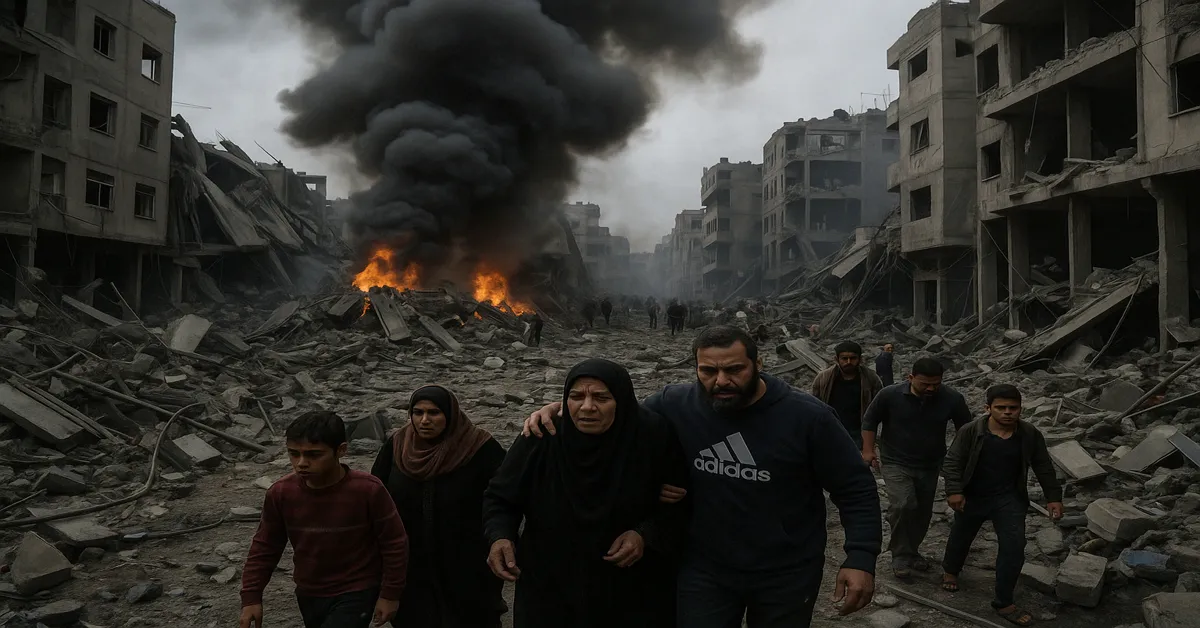GAZA CITY, April 20, 2025 — In the pre-dawn hours of Saturday morning, Gaza was shaken by a series of powerful airstrikes launched by the Israeli military, resulting in what health officials described as one of the deadliest days for civilians since the beginning of the conflict last year. According to Gaza’s Health Ministry, at least 58 Palestinians were killed and more than 170 wounded in the latest wave of Israeli attacks, which targeted residential neighborhoods, suspected militant hideouts, and infrastructure across the densely populated enclave.
The Israeli government said the strikes were in response to ongoing rocket fire and escalating threats from militant groups operating within Gaza. Prime Minister Benjamin Netanyahu, in a televised address, vowed that Israel would continue its military operations until “the security of our citizens is fully restored.”
But with civilian casualties mounting and critical infrastructure crumbling, the international community is expressing growing concern about the humanitarian crisis unfolding in Gaza. The United Nations, European Union, and several human rights organizations have called for an immediate cease-fire and urged all parties to return to negotiations.
Scenes of Devastation
Residents in neighborhoods hit hardest by the strikes reported scenes of chaos and despair. In Al-Zeitoun, one of Gaza City’s oldest and most densely populated districts, witnesses described entire buildings reduced to rubble within seconds. Rescue workers scrambled to pull survivors from beneath concrete slabs as smoke and dust clouded the narrow streets.
“We woke up to the sound of explosions,” said Ahmad Barakat, 32, a father of three who lives near one of the strike zones. “There was no warning. The house next door collapsed with the family still inside. It’s like the earth shook.”
Hospitals, already operating beyond capacity, were quickly overwhelmed. At Al-Shifa Hospital, the largest medical facility in Gaza, doctors worked in shifts around the clock, many without access to adequate supplies or electricity. In makeshift triage units set up in hospital courtyards, wounded children, elderly civilians, and entire families waited for treatment.
“We are treating patients on the floor,” said Dr. Hanan Al-Kurd, a pediatrician. “We are running out of blood, antibiotics, even clean water.”
Israel’s Military Objectives and Tactics
The Israeli Defense Forces (IDF) stated that Saturday’s operations targeted command centers, weapons caches, and tunnels used by Hamas and other militant factions. A spokesperson said intelligence indicated that senior militant leaders were using civilian structures as shields, a tactic Israel says necessitates precise but aggressive responses.
“We regret any civilian casualties,” said IDF spokesperson Lt. Col. Eli David. “But the responsibility lies with the terrorist organizations who embed themselves among the population.”
Israel has relied heavily on airpower, including fighter jets and drones, to conduct precision strikes. Satellite-guided munitions were reportedly used in over 75 percent of Saturday’s bombings. However, Gaza’s urban density and the proximity of homes to military targets have led to high civilian tolls.
The military campaign comes after a week of renewed cross-border hostilities. Militants in Gaza launched more than 300 rockets into southern Israel, many intercepted by Israel’s Iron Dome defense system. Still, several projectiles struck homes and schools, injuring at least 15 Israeli civilians, according to Israel’s Health Ministry.
A Worsening Humanitarian Crisis
Beyond the immediate death toll, the airstrikes have exacerbated a worsening humanitarian crisis in Gaza, where two million residents live under a blockade imposed by Israel and Egypt since 2007. The region already suffers from chronic shortages of fuel, medicine, and potable water. Power outages are routine, and unemployment is among the highest in the world.
International aid agencies report that thousands of Gazans have fled their homes in fear of further attacks, seeking shelter in overcrowded schools and mosques. The United Nations Relief and Works Agency (UNRWA) estimates that more than 25,000 people are now internally displaced.
“This is a catastrophe in the making,” said Philippe Lazzarini, Commissioner-General of UNRWA. “Without a cessation of hostilities and immediate humanitarian access, we are looking at a complete breakdown of civil life in Gaza.”
Calls for Accountability and Cease-Fire
The rising civilian death toll has reignited calls for international accountability. Human Rights Watch and Amnesty International have both urged the International Criminal Court to investigate potential war crimes committed by all parties in the conflict.
“Deliberately targeting civilians or carrying out indiscriminate attacks is a grave violation of international humanitarian law,” said Agnès Callamard, Secretary General of Amnesty International.
Diplomatic efforts for a cease-fire are ongoing, but progress remains elusive. Egyptian and Qatari mediators, who have brokered truces in the past, are said to be engaged in shuttle diplomacy between Tel Aviv and Gaza. However, sources close to the talks say mutual distrust and competing political agendas continue to hinder a breakthrough.
The Broader Political Context
The current flare-up follows months of tension in the region, including Israeli police raids in East Jerusalem, settler violence in the West Bank, and controversial legislative moves by Israel’s far-right government. Critics argue that the Netanyahu administration’s hardline policies have inflamed an already volatile situation.
Within Gaza, Hamas remains the de facto authority, but the group’s leadership is facing increasing pressure from rival factions and a frustrated population. For many Palestinians, the continued blockade, economic stagnation, and unrelenting violence have fueled despair and radicalization.
“There is no future here,” said Lina Abu Said, a 24-year-old university student whose campus was closed due to the airstrikes. “We live in fear every day, and the world just watches.”
A Region on the Brink
As the violence escalates, fears are growing that the conflict could spread beyond Gaza’s borders. Protests erupted in Jordan, Lebanon, and Turkey over the weekend, with demonstrators condemning Israel’s actions and expressing solidarity with Palestinians. Iran and Hezbollah have issued statements warning of consequences if the attacks continue.
In the United States, President Emily Harris has called for “urgent de-escalation” and affirmed America’s commitment to Israel’s security while urging restraint. A bipartisan delegation of U.S. lawmakers is expected to visit the region this week to assess the situation firsthand.
Meanwhile, on the ground in Gaza, ordinary civilians brace for what many fear will be a prolonged and devastating campaign.
“We have nowhere to go,” said Youssef Al-Najjar, a grocer in Khan Younis whose shop was destroyed. “We just want to live. But every time we rebuild, the bombs come again.”
Conclusion
The events unfolding in Gaza reflect not just a military confrontation, but a profound human tragedy. As airstrikes continue and diplomatic channels falter, the people of Gaza find themselves once again caught in the crossfire of geopolitical forces beyond their control. Whether through political will, international pressure, or humanitarian intervention, a path to peace remains not just necessary, but urgent.











